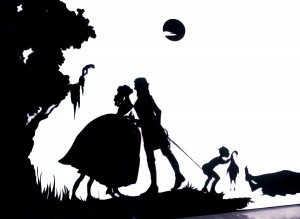Munch…more than just “The Scream”
Edvard Munch, Norway’s greatest artist and famous for The Scream, once hooted and jeered by the public? How could that be?
Munch’s paintings were revolutionary. The technique of scratching, layering and smudging the canvas was unheard of.
His subjects were the complex ones of life, death, anxiety and human sexuality…frightening in their intensity and beauty, they have become icons causing Munch to be a precursor of modern psychology. We sense the spirit of Sigmund Freud hovering just beyond the frame!
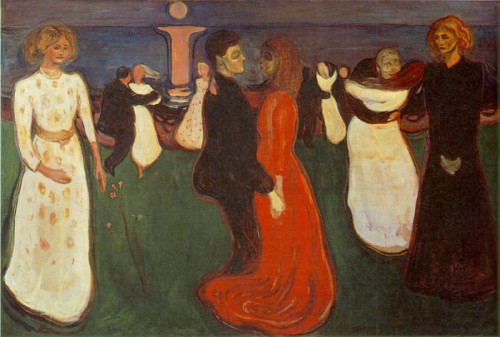
Dance of Life, 1900
Edvard Munch
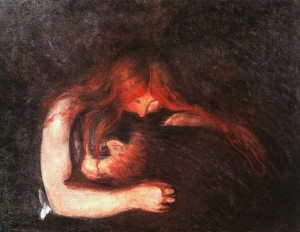
Love and Pain, 1895
Edvard Munch

The Sick Child, 1886
Edvard Munch
Only when he was 45 and famous abroad did Norway recognize Munch with the Royal Order of St. Olav.
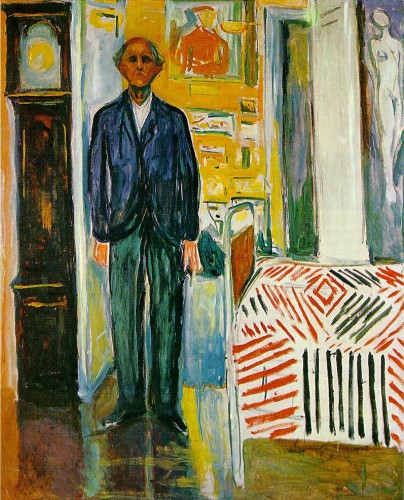
Self-Portrait. Between the Clock and the Bed, 1943
Edvard Munch
Munch, who never married, lived alone on his estate and became increasingly isolated, yet revered by his public. He called his paintings his children and hated to be separated from them.
Self-Portrait. Between the Clock and the Bed was his last masterpiece, painted shortly before he died at the at the age of 80. This final self-portrait showed the elderly artist standing between a grandfather clock and a bed, two harbingers at the end, his suit loose on his shrinking frame, his features barely there. The canvas is crammed with details – the paintings “his children” in the room behind him and the patterned bedspread on the single bed.
We see what had become of the man who, as he wrote, hung back from “the dance of life.”
See Munch’s most famous paintings. Click here if unable to view the video.
Cubism Understood at Last!
The Father of Modern Art…Picasso? Nope.
Linda Blair, renowned San Diego Art Historian, asserts Paul Cézanne, French painter in the latter part of the 1800‘s, as the precursor of Cubism and hence, the true Father of Modern Art…not Picasso!
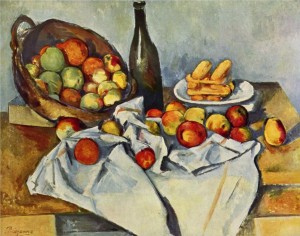
Basket of Apples, 1985
Paul Cézanne
Linda Blair’s vivid interpretation of Basket of Apples gives us that ‘Aha’ moment! Surprisingly, we now understand Cézanne’s painting with all its ruthless brushwork, tension, and distortion!
“In Basket of Apples the bottle tilts toward the basket to halt the tumbling apples, while the cloth seems to slither off the table but is itself halted by the higher right side of the table.
The curious perspective of the cookies in the upper right suggests their desire to move downward to join the apples. The misalignment of the table confuses visual expectation and furthers the tension.
Cubism threw traditional painting to the wind. The subject matter was fragmented with several sides seen simultaneously. Thus, the Cubist moves the viewer through time, as if he were walking around the object. This introduces a new relationship between the art work and the viewer – the viewer is now a participant!“
Linda Blair, Art Historian
Test your Cubism knowledge and watch this video!
Click here if unable to view the video.
Back by Popular Demand: Picasso, you rascal, you!
Picasso:
“I remember one day while I was painting Guernica in the big studio in the Rue des Grands-Augustins, Dora Maar was with me. Marie-Therese dropped in and when she found Dora there, she grew angry and said to her ‘I have a child by this man. It’s my place to be here with him. You can leave right now.’
Dora said, ‘I have as much reason as you have to be here. I haven’t borne him a child but I don’t see what difference that makes.’
I kept on painting and they kept on arguing.
Finally, Marie-Therese turned to me and said, ‘Make up your mind. Which one of us goes?’
It was a hard decision to make. I liked them both, for different reasons: Marie-Therese because she was sweet and gentle, and did whatever I wanted her to; Dora because she was intelligent. I decided I had no interest in making a decision. I was satisfied with things as they were. I told them they’d have to fight it out themselves. So they began to wrestle. It’s one of my choicest memories.”
Hall, D. & Wykes, P. (1990). Anecdotes of Modern Art. As Picasso told Francoise Gilot.
Watch the great Picasso paint!
Click here to view the video.
Degas At The Races
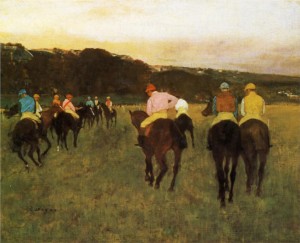
Race Horses at Longchamp, 1874
Edgar Degas
Edgar Degas, one of the greatest French Impressionists of the mid-1800’s, painted more than just ballerinas. Yes, indeed.
In the winter of 1872 Degas traveled to New Orleans, the birthplace of his mother, and became enamored with horses and the famous New Orleans Fairgrounds’ Racetrack.
Result: masterpiece equine paintings!

Race Horses at Longchamp, 1873
Edgar Degas
Today you may walk down Esplanade Ave, where his mother’s family lived, and follow the artist’s footsteps on the way to that same racecourse.
_______________
Dawn Harris Brown, New Orleans cookbook author, imagines what Degas and friends would eat and drink after a “tough” day at the races in the 19th century…and the 21st century!

Tally-ho Cocktail
Tally-ho Cocktail
2 ounces grenadine (a syrup, from the French word meaning pomegranate)
2 ounces sloe gin
2 ounces triple sec
2 ounces rum
juice of 1 lime
2 cups crushed ice
1. Place all ingredients in a blender and blend for 30 seconds.
2. Pour into a martini glass.
3. Decorate with a continuous peeled lime attached to the lip of glass and entwined around the stem. Garnish with a cherry. Serve immediately.
Tally-ho, Monsieur Degas!
Heroes
Heroes arise from everyday life. Supernatural and powerful forces lead the ordinary person to perform wondrous deeds, often bestowing good upon their fellow man.
_______________
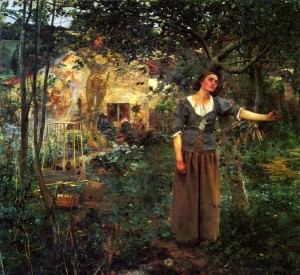
Joan of Arc, 1879, Jules Bastien-Lepage,
Metropolitan Museum of Art. Joan in her garden receiving messages from the saints.
Joan of Arc’s story is one of those rare events in history which actually happened!
The seventeen-year-old illiterate farm girl from eastern France disguised herself as a man in her war campaigns against English oppression. Joan claimed she heard voices from a trio of saints telling her to deliver France from the English.
Captured in 1430, Joan was tried for heresy and burned at the stake. Five hundred years later, in 1920, Joan of Arc was made a saint.
_______________

Cotton Picking, c. 1955
Clementine Hunter
200 years ago a poor black woman, Harriet Tubman, was born into slavery in Maryland. In spite of a childhood of hardship and deprivation, she emerged a hero battling this tyranny. She escaped her master 12 years before the Civil War and fled northward with the help of the Underground Railroad. Tubman persevered in helping other slaves find sanctuary in northern states and became a hunted woman in the South with a price on her head.
Harriet Tubman is referred to as the “Moses of her people.”
Contemporary artist, Kara Walker, shatters any romantic notion of the South, Civil War or slavery. Walker cuts out huge life-size silhouettes in black paper…nightmarish images of slavery in the Antebellum South.
Watch this video of Kara Walker’s Civil War art.
Click here if unable to view the video.



